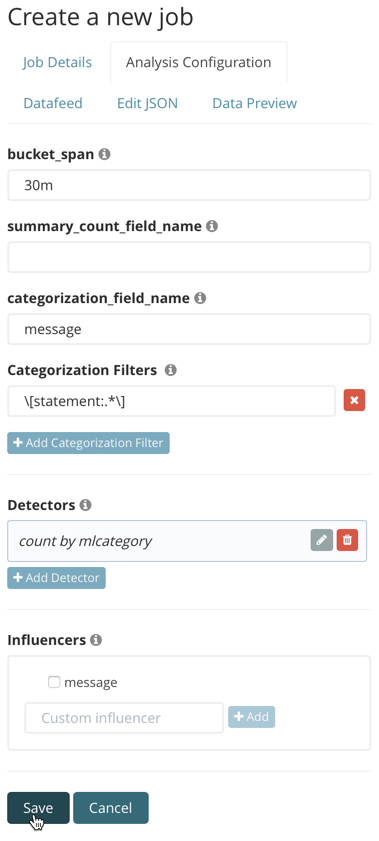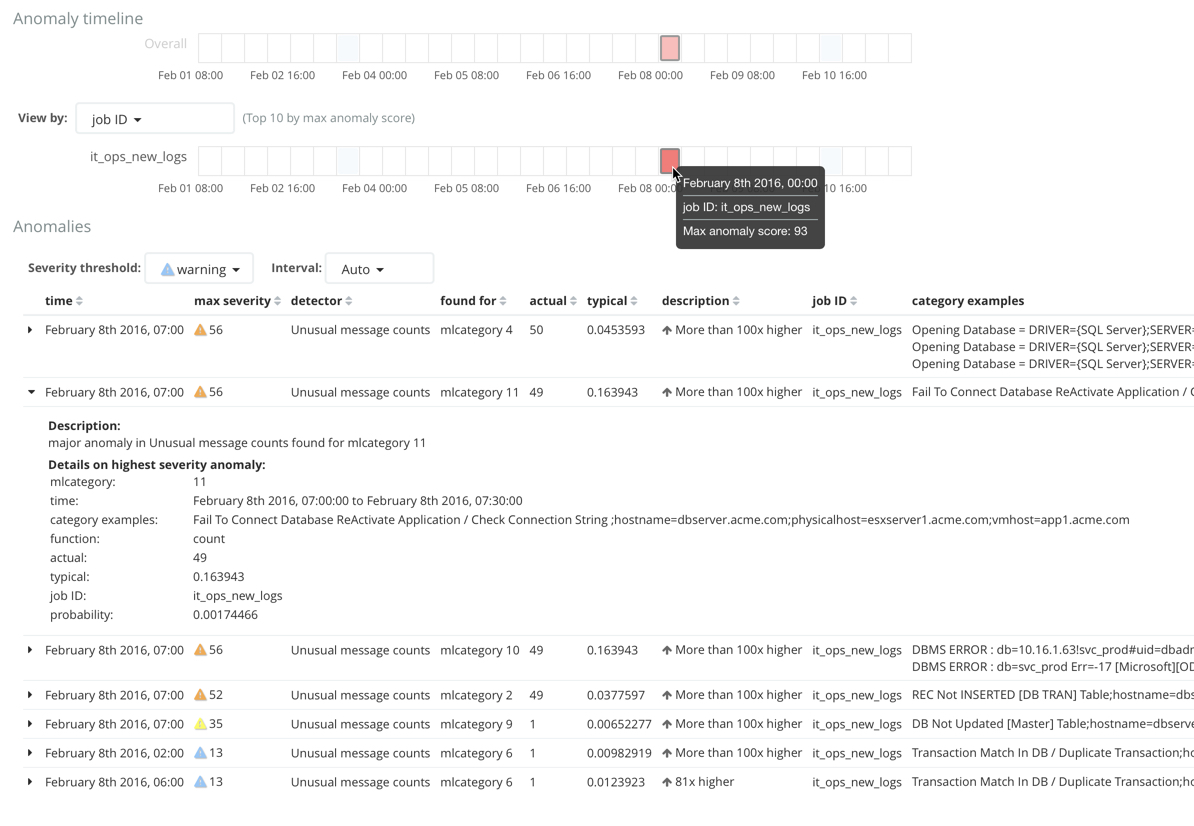Categorizing log messages
editCategorizing log messages
editApplication log events are often unstructured and contain variable data. For example:
{"time":1454516381000,"message":"org.jdbi.v2.exceptions.UnableToExecuteStatementException: com.mysql.jdbc.exceptions.MySQLTimeoutException: Statement cancelled due to timeout or client request [statement:\"SELECT id, customer_id, name, force_disabled, enabled FROM customers\"]","type":"logs"}
You can use machine learning to observe the static parts of the message, cluster similar messages together, and classify them into message categories.
The machine learning model learns what volume and pattern is normal for each category over time. You can then detect anomalies and surface rare events or unusual types of messages by using count or rare functions. For example:
PUT _ml/anomaly_detectors/it_ops_new_logs
{
"description" : "IT Ops Application Logs",
"analysis_config" : {
"categorization_field_name": "message",
"bucket_span":"30m",
"detectors" :[{
"function":"count",
"by_field_name": "mlcategory",
"detector_description": "Unusual message counts"
}],
"categorization_filters":[ "\\[statement:.*\\]"]
},
"analysis_limits":{
"categorization_examples_limit": 5
},
"data_description" : {
"time_field":"time",
"time_format": "epoch_ms"
}
}
|
The |
|
|
The resulting categories are used in a detector by setting |
The optional categorization_examples_limit property specifies the
maximum number of examples that are stored in memory and in the results data
store for each category. The default value is 4. Note that this setting does
not affect the categorization; it just affects the list of visible examples. If
you increase this value, more examples are available, but you must have more
storage available. If you set this value to 0, no examples are stored.
The optional categorization_filters property can contain an array of regular
expressions. If a categorization field value matches the regular expression, the
portion of the field that is matched is not taken into consideration when
defining categories. The categorization filters are applied in the order they
are listed in the job configuration, which allows you to disregard multiple
sections of the categorization field value. In this example, we have decided that
we do not want the detailed SQL to be considered in the message categorization.
This particular categorization filter removes the SQL statement from the categorization
algorithm.
If your data is stored in Elasticsearch, you can create an advanced anomaly detection job with these same properties:

To add the categorization_examples_limit property, you must use the
Edit JSON tab and copy the analysis_limits object from the API example.
Customizing the categorization analyzer
editCategorization uses English dictionary words to identify log message categories. By default, it also uses English tokenization rules. For this reason, if you use the default categorization analyzer, only English language log messages are supported, as described in the Limitations.
You can, however, change the tokenization rules by customizing the way the categorization field values are interpreted. For example:
PUT _ml/anomaly_detectors/it_ops_new_logs2
{
"description" : "IT Ops Application Logs",
"analysis_config" : {
"categorization_field_name": "message",
"bucket_span":"30m",
"detectors" :[{
"function":"count",
"by_field_name": "mlcategory",
"detector_description": "Unusual message counts"
}],
"categorization_analyzer":{
"char_filter": [
{ "type": "pattern_replace", "pattern": "\\[statement:.*\\]" }
],
"tokenizer": "ml_classic",
"filter": [
{ "type" : "stop", "stopwords": [
"Monday", "Tuesday", "Wednesday", "Thursday", "Friday", "Saturday", "Sunday",
"Mon", "Tue", "Wed", "Thu", "Fri", "Sat", "Sun",
"January", "February", "March", "April", "May", "June", "July", "August", "September", "October", "November", "December",
"Jan", "Feb", "Mar", "Apr", "May", "Jun", "Jul", "Aug", "Sep", "Oct", "Nov", "Dec",
"GMT", "UTC"
] }
]
}
},
"analysis_limits":{
"categorization_examples_limit": 5
},
"data_description" : {
"time_field":"time",
"time_format": "epoch_ms"
}
}
|
The
|
|
|
The |
|
|
By default, English day or month words are filtered from log messages before categorization. If your logs are in a different language and contain dates, you might get better results by filtering the day or month words in your language. |
The optional categorization_analyzer property allows even greater customization
of how categorization interprets the categorization field value. It can refer to
a built-in Elasticsearch analyzer or a combination of zero or more character filters,
a tokenizer, and zero or more token filters.
The ml_classic tokenizer and the day and month stopword filter are more or less
equivalent to the following analyzer, which is defined using only built-in Elasticsearch
tokenizers and
token filters:
PUT _ml/anomaly_detectors/it_ops_new_logs3
{
"description" : "IT Ops Application Logs",
"analysis_config" : {
"categorization_field_name": "message",
"bucket_span":"30m",
"detectors" :[{
"function":"count",
"by_field_name": "mlcategory",
"detector_description": "Unusual message counts"
}],
"categorization_analyzer":{
"tokenizer": {
"type" : "simple_pattern_split",
"pattern" : "[^-0-9A-Za-z_.]+"
},
"filter": [
{ "type" : "pattern_replace", "pattern": "^[0-9].*" },
{ "type" : "pattern_replace", "pattern": "^[-0-9A-Fa-f.]+$" },
{ "type" : "pattern_replace", "pattern": "^[^0-9A-Za-z]+" },
{ "type" : "pattern_replace", "pattern": "[^0-9A-Za-z]+$" },
{ "type" : "stop", "stopwords": [
"",
"Monday", "Tuesday", "Wednesday", "Thursday", "Friday", "Saturday", "Sunday",
"Mon", "Tue", "Wed", "Thu", "Fri", "Sat", "Sun",
"January", "February", "March", "April", "May", "June", "July", "August", "September", "October", "November", "December",
"Jan", "Feb", "Mar", "Apr", "May", "Jun", "Jul", "Aug", "Sep", "Oct", "Nov", "Dec",
"GMT", "UTC"
] }
]
}
},
"analysis_limits":{
"categorization_examples_limit": 5
},
"data_description" : {
"time_field":"time",
"time_format": "epoch_ms"
}
}
|
Tokens basically consist of hyphens, digits, letters, underscores and dots. |
|
|
By default, categorization ignores tokens that begin with a digit. |
|
|
By default, categorization also ignores tokens that are hexadecimal numbers. |
|
|
Underscores, hyphens, and dots are removed from the beginning of tokens. |
|
|
Underscores, hyphens, and dots are also removed from the end of tokens. |
The key difference between the default categorization_analyzer and this example
analyzer is that using the ml_classic tokenizer is several times faster. The
difference in behavior is that this custom analyzer does not include accented
letters in tokens whereas the ml_classic tokenizer does, although that could
be fixed by using more complex regular expressions.
For more information about the categorization_analyzer property, see
Categorization analyzer.
To add the categorization_analyzer property in Kibana, you must use the
Edit JSON tab and copy the categorization_analyzer object from one of the
API examples above.
Viewing categorization results
editAfter you open the job and start the datafeed or supply data to the job, you can view the categorization results in Kibana. For example:

For this type of job, the Anomaly Explorer contains extra information for
each anomaly: the name of the category (for example, mlcategory 11) and
examples of the messages in that category. In this case, you can use these
details to investigate occurrences of unusually high message counts for specific
message categories.